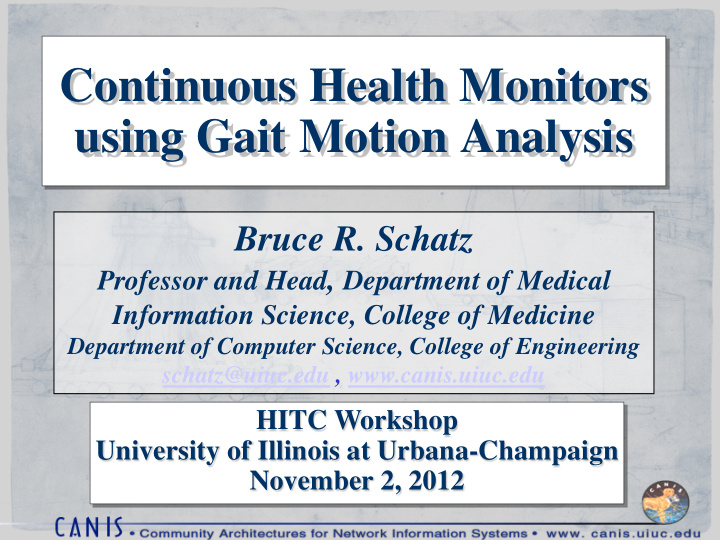



Continuous Health Monitors using Gait Motion Analysis Bruce R. Schatz Professor and Head , Department of Medical Information Science, College of Medicine Department of Computer Science, College of Engineering schatz@uiuc.edu , www.canis.uiuc.edu HITC Workshop University of Illinois at Urbana-Champaign November 2, 2012
Healthcare Infrastructure Acute Care Continuous monitor in hospital Follow up is Heart Monitor Chronic Care Continuous monitor in home Requires using everyday devices Health Care Automatic monitor for abnormal situations Automatic diagnosis for care routing
Continuous Health Monitors Vital Signs: Body temperature, Blood pressure Heart Rate, Respiration Rate Diet camera or location with database Exercise motion or heartrate with compute Stress skin response (wrist) Sleep skin temperature (arm) Energy in (diet,sleep) measured Energy out (exercise,stress) measured Biorhythms voice log or text type Life Events
The New Vital Signs
The Importance of Gait Harrison’s Principles of Internal Medicine: “Watching a patient walk is the most important part of the neurological examination. Normal gait requires that many systems, including strength, sensation, and coordination, function in an integrated fashion”. As this indicates, the walking pattern (gait) can monitor both physical problems (injury) and mental problems (anxiety).
Gait Analysis with Smartphones
Computing Gait
Autodetect Sickness and Wellness
Gait Motion Analysis In pocket, pack, purse, hand Compute forward motion only Use Gait Speed and Variation
Gait Motion Analysis Stages to measure Gait Speed Variation 1. SensorData. Record, conserve energy. 2. GaitRecognize. Speed, forward motion. 3. PersonalModel. Trained, normal compare. 4. SituationRecord. Annotate, when abnormal.
GMA: SensorData Orientation via Triple-Axis Accelerometer also Magnetometer and Gyroscope Motion in Space Accuracy comparable to medical sensor and to treadmill SensorData for iPhone mobiles (iPod Touch) AndroSensor app for Android mobiles actually use Samsung Galaxy Ace ($200)
GMA: GaitRecognize Must eliminate non-walking motion sensors for forward vector only walking speeds, up/down stairs, up/down hills Must eliminate non-walking activities stationary: sitting, standing running, bicycling, vehicle riding
GMA: PersonalModel Variation across Age, Sex, Weight
GMA: SituationRecord Training period: days vs minutes Training place: free-range vs treadmill Normal Assess: binary, task-dependent Physiological: MET, oxygen consume Psychological: SF-8, quality of life Annotation: free-text complaints by voice
GMA: Clinical Trials Teenagers with Asthma ( Jason Leigh UIC ) when time to take inhaler dosage Adults with COPD (Jerry Krishnan UIC) 6 minute walk test via phone + pulseox Trauma Patients during Injury Rehab track improving mobility to normal
Personal Health Messages ...when I gave up coffee and sugar in earnest and stopped the amitrptyline I was taking I am feeling much better still especially depression wise and the heavyness and sluggishnes that was in my legs is leaving. I am also getting back into a more normal sleep pattern of getting sleepy by normal time in evening and waking up in the morning more normally. I believe the years of amitriptyline for muscle relaxant were doing more damage than good and am doing pretty good controlling my night time bladder spasms by no coffee, magnesium...
Message Outcomes clustered
Recommend
More recommend